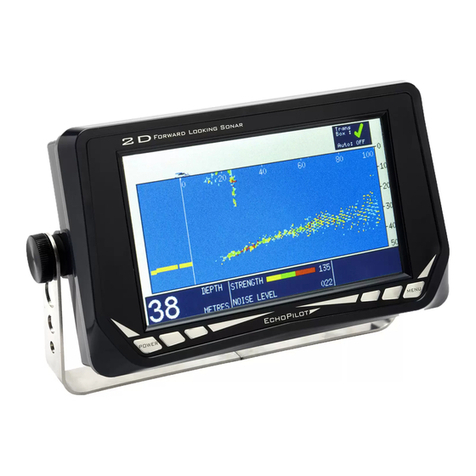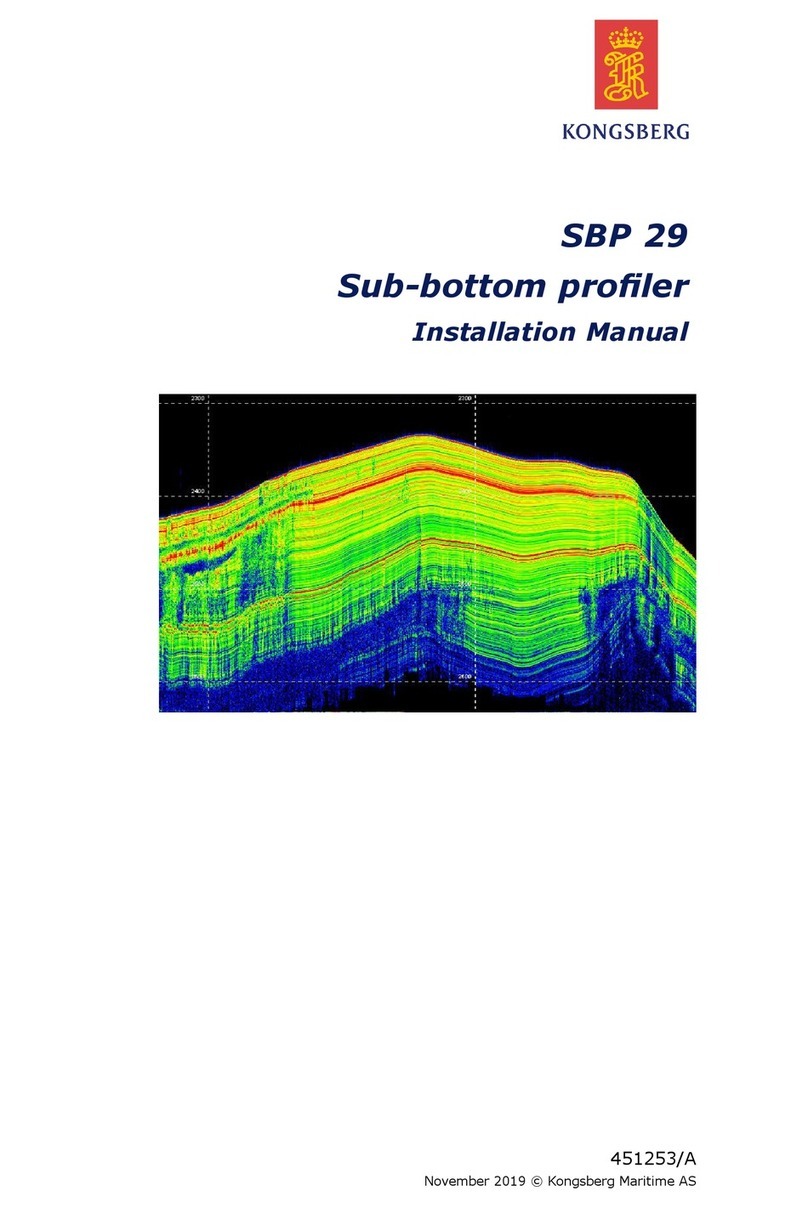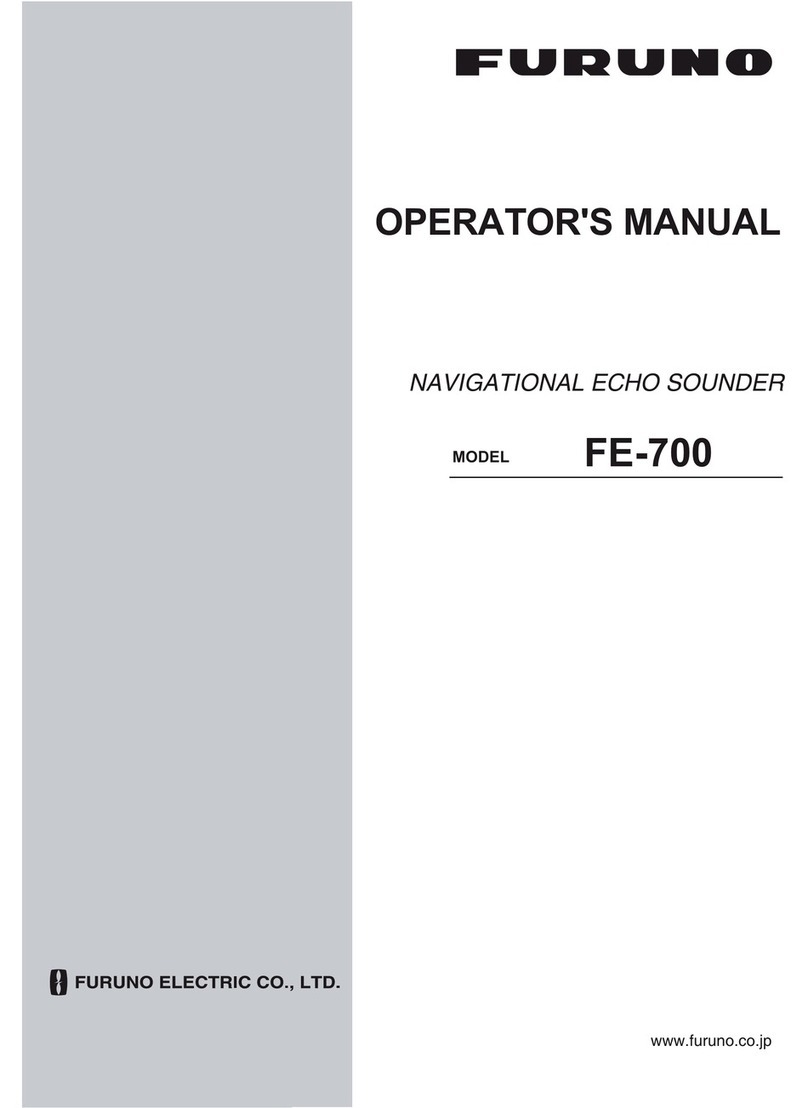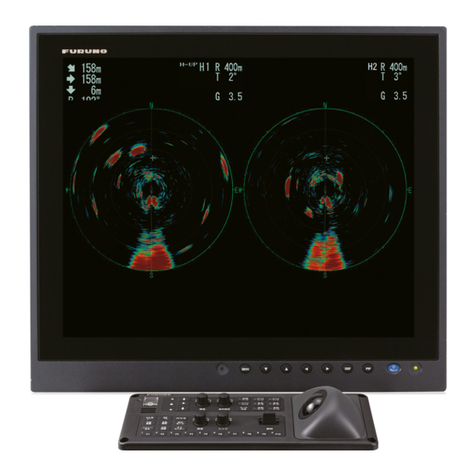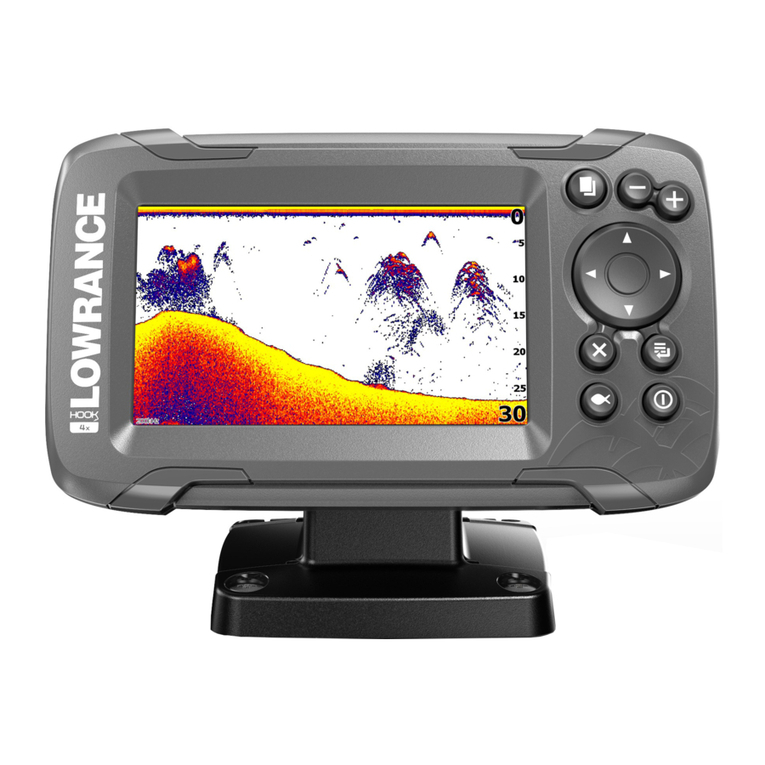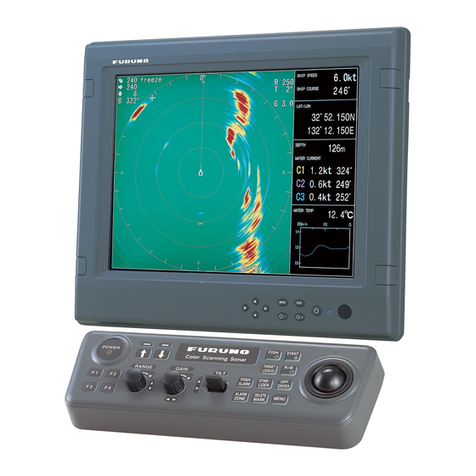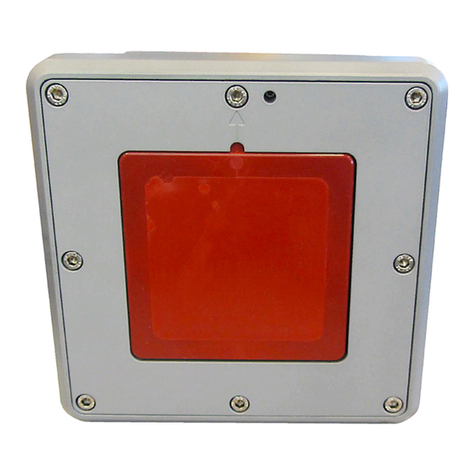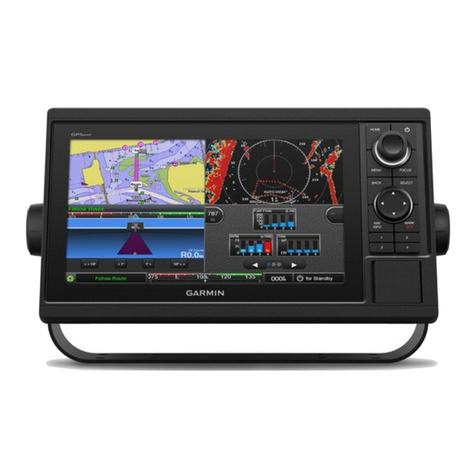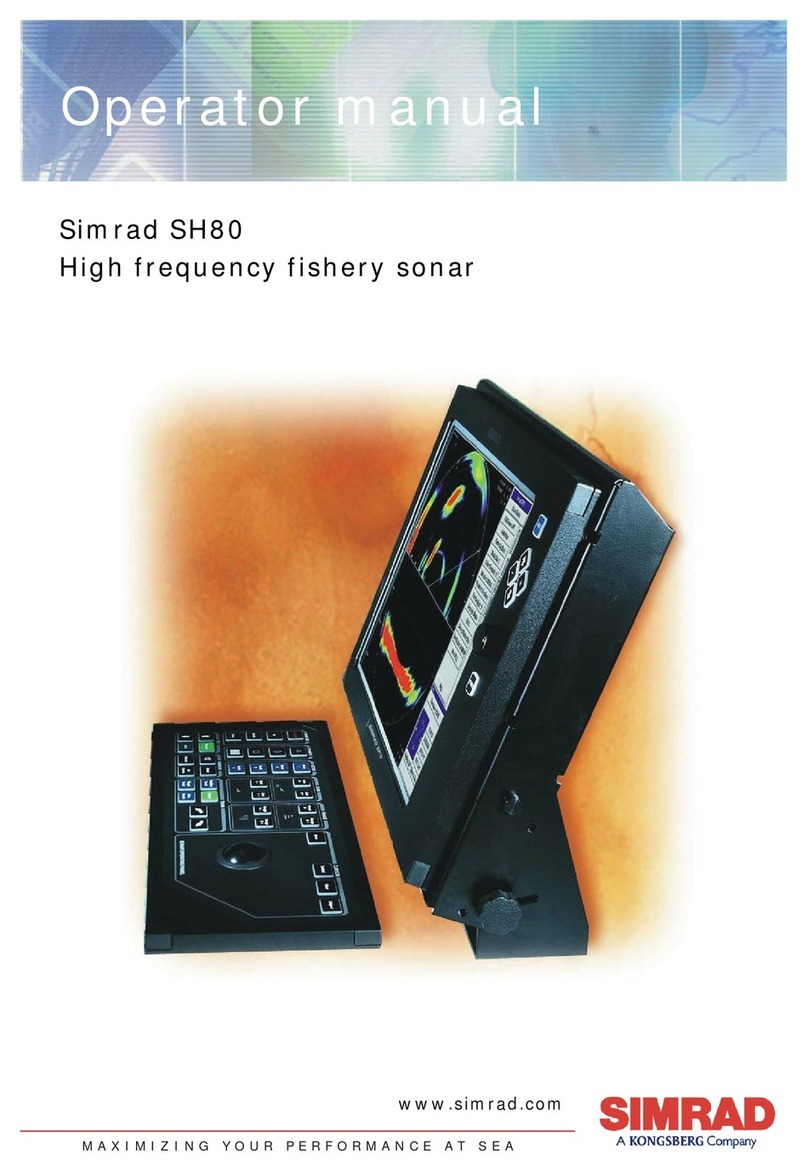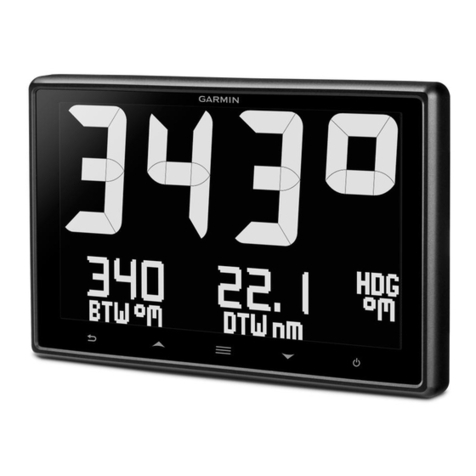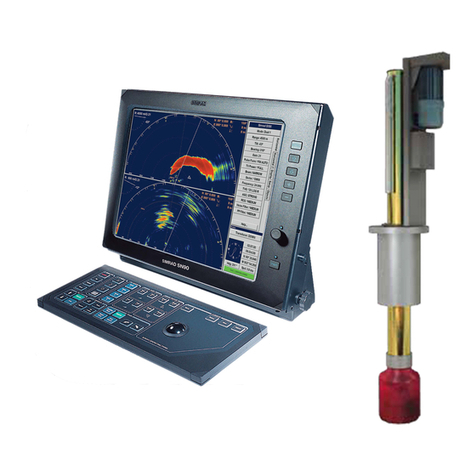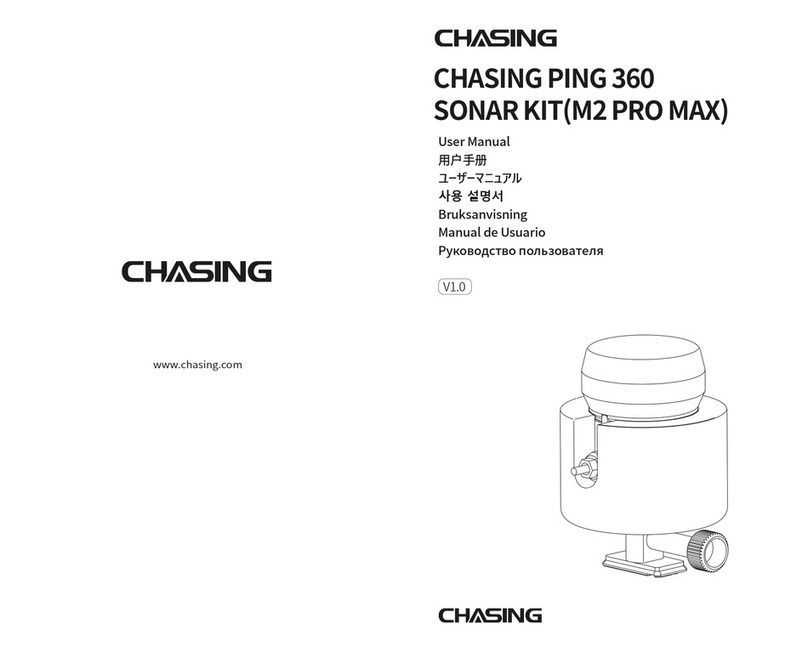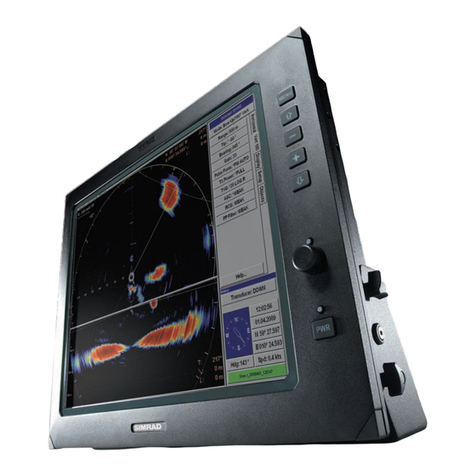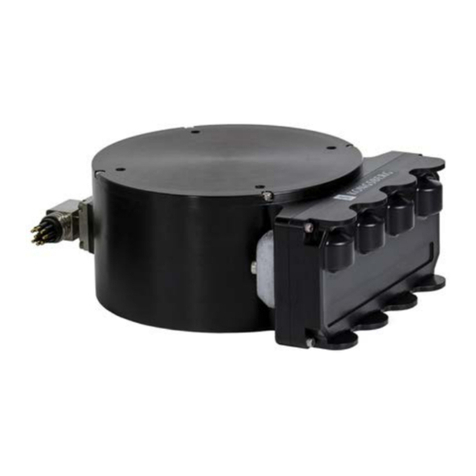EchoPilot fls platinum User manual

32 FLS Platinum Instruction Manual
We hope you enjoy using your EchoPilot FLS Platinum
WE ARE ALWAYS PLEASED TO TALK TO OUR CUSTOMERS.
Information in this document is subject to change without notice. No part of this document may be
reproduced or transmitted in any form or by any means, electronic or mechanical, for any purpose, without
the express written permission of EchoPilot Marine Electronics Ltd.
Copyright © 2005 by EchoPilot Marine Eletronics Ltd. All rights reserved.
Protected by USA Patent 5530680 and European (UK) Patent 0624253
Author: Paul Beeston
Last Updated: 29.11.2017 (Johnny Christensen)
For up to date information and advice, please telephone, browse our Website, or send
us an E-Mail.
e-mail: [email protected]
website: www.echopilot.com
NMEA 0183 (ver 2.0) Accepted Input Sentences
Formatter Description
BWC Bearing and Distance to Waypoint
BWR Bearing and Distance to Waypoint, Rhumb Line
DBT Depth Below Transducer
DPT Depth
GGA Global Positioning System Fix Data
GLL Geographic Position, Latitude/Longitude
RMA Recommended Minimum Specific Loran-C Data
RMB Recommended Minimum Navigation Information
RMC Recommended Minimum Specific GPS/TRANSIT Data
VHW Water Speed and Heading
VLW Distance Travelled through the Water
VTG Track Made Good and Ground Speed
ZDA Time and Date
NMEA 0183 (ver 2.0) Output Sentences
All sentences accepted by the FLS Platinum are also output.
Depth & log sentence information output from the unit will depend on the depth and log source selected. If
the depth & log sources are set to local, then the depth and log sentences output will be the internally
calculated depth/log data.
Sentences are output at 2 second intervals.
1
FLS Platinum Instruction Manual
ECHOPILOT MARINE ELECTRONICS LTD
1 Endeavour Park, Crow Arch Lane, Ringwood,
Hampshire, United Kingdom. BH24 1SF.
Telephone: 01425 476211/2 Fax: 01425 474300
E-Mail: info@echopilot.com
Webpage: www.echopilot.com
Professional
Forward Looking Sonar
DANIAMANT ELECTRONICS A/S
Industrivej 24C,
3550 Slangerup, Denmark
Telephone: 0045 47373800
E-Mail: [email protected] /
Webpage: www.echopilot.com
FLS Platinum
FORWARD LOOKING SONAR
INSTRUCTIONS

2FLS Platinum Instruction Manual
Thank you for purchasing this Echopilot instrument.
Your new EchoPilot instrument has been manufactured to the highest standards by
the dedicated staff of a company with many years of experience in marine electronics.
You have invested in the most up to date technology available and in a product
rigorously tested in the laboratory and at sea.
All goods of our manufacture are backed by a 2 year warranty. Expert advice and
guidance is always available by Telephone +45 4737 3800 - just ask for customer
service. If you are outside the UK you can still call us or any of our overseas
distributors. We welcome the opportunity to talk to our customers.
Nobody enjoys reading manuals, but please continue to read this one! Installing
your instrument correctly is vital to get the maximum performance, pleasure
and safety from your equipment, so please take the time to read the instructions.
Please observe the following warnings:
Please do not cut the transducer cables - they are fine multi-core cable matched to
the transducer.
Please do not remove the transducer plug from its cable - if a hole is too small
make the hole bigger! Any join in the cable will reduce sensitivity / performance.
Disclaimer
Echopilot makes no warranty as to the accuracy or completeness of
data that is included or may be downloaded or used in connection
with this product, and EchoPilot disclaims any and all express,
implied or statutory warranties including the implied warranty of
merchantability and implied warranty of fitness for a particular
purpose. It is the user’s responsibility to use this product
prudently. This product is intended to be used only as a secondary
aid to navigation and must not be used for any purpose requiring
precise measurement of distance, depth, location, or topography.
31
FLS Platinum Instruction Manual
FLS Platinum Notes

30 FLS Platinum Instruction Manual
FLS Platinum - Notes
3
FLS Platinum Instruction Manual
Operating Instructions 4
Switching on 4
Keypad Operation - Overview 5
Operating Modes 5
Changing the Unit Settings 11
Operating a Repeater Unit 15
How FLS Technology Works 16
Some Guidance on Use 17
Installation Instructions 18
Transducer Installation 18
Wiring Diagrams 21
Fitting the Transmitter Box 22
Applying Power 23
Maintenance 23
Fault Finding 24
Technical Specification 25
Technical Drawings 26
Contents

4FLS Platinum Instruction Manual
FLS Platinum Operating
Switching On
The FLS Platinum is switched on by pressing and holding the power key until a
single beep is heard. The unit will then display the introduction screen that includes
the unit software version, shortly followed by the FLS sonar display.
The sonar data displayed on the screen will depend on the sea bed below the
transducer. The unit will always switch on in ‘Auto Range’ mode which means that
if a good seabed signal is received, a suitable range will be chosen for the current
depth. Pressing the up or down arrows will turn off auto mode and the user will now
have control of the range with the up and down arrows.
Power Key
Menu Key
Up/Down Keys
Mode Key
Page Key
29
FLS Platinum Instruction Manual
FLS Platinum Notes

28 FLS Platinum Instruction Manual
FLS Platinum - Notes
5
FLS Platinum Instruction Manual
FLS Platinum Operating
Keypad Operation - Overview
Power Key: Switches the unit on and off.
Menu Key: Selects the menu which allows the user to modify the unit settings. See
the section Changing the Unit Settings for more information on the menu.
Up/Down Keys: When in FLS Mode (sonar data displayed), changes the sonar range
up or down accordingly. When in the menu, the up and down arrows change the
selected option. See the section Changing the Unit Settings for more information on
the menu.
Mode Key: Cycles between FLS mode, GPS mode and Test Mode. When in the
menu, the mode key returns the user to the current mode. See the relevant sections for
more information on each mode.
Page Key: When in FLS mode, changes the information displayed in the information
bar at the bottom of the screen. See FLS Mode section for more information. When
in Test Mode, cycles through three test screens that will aid in testing the unit and
provide diagnostic information. See Test Mode section for more information. The
page key has no effect in GPS Mode. See GPS Mode section for more information.
Operating Modes
FLS Mode
FLS Mode is the sonar operating mode that displays the sonar image of the seabed
ahead and below the transducer. There are eight forward range settings (20m, 40m,
60m, 80m, 100m, 150m, 200m and Auto) that are selectable with the up and down
arrow keys. When the upper range is reached with the up arrow (200m), a further
press puts the unit onto the ‘Auto’ range. Similarly, when the lower range is reached
with the down arrow, a further press puts the unit onto the Auto range. A press of
either arrow key while Auto is on will switch the Auto off and the user will retain
manual control of the range.
When returning to manual range, the range selected will be the last range selected by
the Auto function until the user presses an arrow key to change range.

6FLS Platinum Instruction Manual
FLS Platinum Operating
Auto Range
When Auto range is selected, the range will automatically be set, based on the
current digital depth (displayed in bottom left hand corner). If the digital depth is
invalid due to a poor sonar signal (indicated by the depth figure flashing) the range
will remain on the last selected range for a valid depth. The status indicator box in
the top right hand corner of the display shows whether Auto range has been
selected.
Status Indicator Box
This box is displayed in the top right hand corner of the screen in FLS Mode and
shows that the Transmitter Box is connected and is communicating with the display
correctly. A green tick indicates a successful connection and a red cross indicates that
the transmitter box is not properly connected (no power to the transmitter box and/or
not connected to the display unit).
The status indicator also shows whether Auto Range is on or off.
History Display
The FLS Platinum displays a 15 second history to the left of the vertical line (0m
line) on the sonar display. The history plot is based on the digital depth readout and
gives the user a little more information about the shape of the seabed behind the
vessel.
As the history plot is the last 15 seconds of seabed, the area of seabed covered will
depend on the speed of the vessel. For example, if the vessel speed is 5 knots (2.5
metres per second), then the history plot will cover a distance of 38m. Higher speeds
will give greater distances but with less accuracy.
The sonar display in FLS Mode
27
FLS Platinum Instruction Manual
FLS Platinum Technical Drawings
Transmitter box

26 FLS Platinum Instruction Manual
FLS Platinum - Technical Drawings
Video Interface
Do under no circumstances unscrew the two mounting brackets !
7
FLS Platinum Instruction Manual
FLS Platinum Operating
Information Window
This is the window at the bottom of the display and displays the current depth and
other optional information. Pressing the page key will scroll through a number of
combinations of this information, the combinations also being dependent on whether
GPS or Log displays are turned off in the menu.
The possible combinations of information are:-
•
Depth Only
•
Depth + Echo Strength
•
Depth + Speed (log displays enabled)
•
Depth + Speed + Log (log displays enabled)
•
Depth + Speed + Echo Strength (log displays enabled)
•
Depth + GPS (GPS displays enabled)
•
Depth + Speed + GPS (log and GPS displays enabled)
Speed and log info can only be displayed if either a paddle wheel transducer is
connected to the display unit (speed through the water) or a GPS is connected to the
unit (speed over the ground). The source of the speed is selected in the menu.
The GPS info box displays waypoint information if it is available from a connected
GPS. If no data is avalable or no GPS is connected, the fields are shown as above.
The Echo Strength Indicator displays the average peak strength of received echo over
the last 4 pings. The coloured bar will increase in length as the strength increases and
the colour of the bar will change at certain thresholds.

8FLS Platinum Instruction Manual
If the bar is yellow, the signal is weak and there is likely to be no (or extremely
poor) seabed picture displayed.
If the bar increases to green, the signal is above the acceptable threshold level to
generate a seabed picture. The picture may be slightly disappointing at this level.
If the bar increases to red, the signal is very good and the seabed picture should also
be good.
GPS Mode
The GPS mode requires an external GPS to be connected and allows the user to
view GPS data such as:-
•
Current position (Lat/Long)
•
Current time (UTC + offset)
•
Speed and course over the ground (COG and SOG)
•
Waypoint info (ID, cross track error (XTE) + steer direction, range and
true bearing to waypont)
The depth is also displayed in GPS Mode.
GPS Mode data including depth
FLS Platinum Operating
25
FLS Platinum Instruction Manual
FLS Platinum Installati
Specification FLS Platinum
Voltage 12v or 24v DC
Current Consumption Display-700mA with max brightnes (300 mA min)
Transmitter Box - 50mA
Operating frequency 200 kHz
Display type 3rd party
Viewing Area Depending on display type
Forward Range 20 to 200 metres
Maximum Depth Range 10 to 100 metres
Display Update
Rates
1-2 updates / sec
NMEA 0183 Version 2.0
Built-in Test Facility Yes
Repeater Option Yes
Alarm Shallow
Transducers FLS Platinum professional
FLS Platinum - Technical Specs

24 FLS Platinum Instruction Manual
FLS Platinum Installation
Instructions
Some Common Faults
Display or transmitter box doesn’t switch on (no display or LEDs lit):-
• Battery not connected
• Battery voltage too low
Transmitter box LED not flashing:-
• No power to display unit or display not switched on
• 12m data cable not connected properly
• Power not cleanly applied to transmitter box - re-make connection
No seabed visible and transmitter box LED is flashing:-
• Transducer not connected (or not connected properly) - use Test Mode
• Incorrect range selected (try using the ‘Auto’ setting!)
Poor seabed picture or excessive noise:-
• Suitable range not selected (try to fill screen with seabed)
• Poor connection of transducer
• Battery voltage low - use Test Mode to check Tx voltage
• Transducer mounted at an angle
• Turbulence at transducer location
• Interference from other 200KHz sounders (same boat or other boats)
• Turbulence/wake from other boats
• Polluted water or Plankton bloom (usually early summer)
• Dirty transducer/covered with barnacles
• Choppy sea state - can cause surface noise
FLS Platinum - Fault Finding
9
FLS Platinum Instruction Manual
Test Mode
This mode allows the user to obtain diagnostic data about the unit should a fault
occur with the display, transmitter box or transducer. The page key scrolls between 3
test pages.
A-Scan and Angle Graphs
These graphs display the sonar signal strength and associated calculated angles over a
30m range. If the depth is greater than 30m, these graphs will not show the received
seabed echo and angle of the seabed.
FLS Platinum Operating
The A-Scan and Angle Graphs
The A-scan graph of a flat seabed will show a low signal level up to the depth of the
seabed and should then increase significantly to a higher lever when the sebed is
reached. This is the returned echo from the seabed. The angle graph will show angles
between 0 and 90 degrees. The angles should start at about 60-70 degrees at the
seabed depth and will decrease gradually as the range of the received echo increases
(for a flat seabed).
The up arrow key allows the user to scroll between the 3 receive channels (A-Scan
graph only). Each channel must be displaying similar A-Scan graphs for the angle to
be calculated correctly. Low or very different echo levels on any of the 3 channels
will cause poor performance of the FLS unit.

10 FLS Platinum Instruction Manual
FLS Platinum Operating
Diagnostics
This screen displays some diagnostic information about the unit. It shows the
software version of both the transmitter box and the display, the status of the
communications link with the transmitter box, the transmitter dc voltage supply and
also tests the settings memory on the display (EEPROM).
Diagnosic Data
‘Trans Box Comms Status’ should read ‘Connected OK’. Any other messages mean
an error has occured on the communications link with the transmitter box. If this is
the case, the user should ensure that the transmitter box has power and the data link
cable is connected securely at both ends (transmtter box and display).
‘Trans Box Tx Volts’ should read approximately 12 Volts. If the transmitter box
supply voltage is at exactly 12 Volts, then the Tx Volts should be about 9-10 Volts.
This will result in slight reduced peformance but should still perform well. If 14 Volts
or more are supplied to the transmitter box, maximum transmit power will be
achieved.
Factory settings can be restored by pressing the up arrow key on this page.
23
FLS Platinum Instruction Manual
FLS Platinum Installation
Interference
Other depth sounders especially those that operate at 200 kHz must be wired so
they can be switched off if interference occurs. (This may appear as ‘submarine’
like echoes coupled with a reduction in sensitivity).
Applying Power
When power is applied to to FLS Platinum system, 2 LEDs on the transmitter box
show the status of power and the communications link to the display unit.
The left LED shows power is reaching the box and this should be lit as soon as power
is applied to the transmitter box.
The right LED should also light upon applying power to the transmitter box. If
successful communication with the display is made, the LED will flash to show that
the display unit is in FLS Mode and that the transmitter box is receiving transmission
requests from the display. If this LED is not flashing, check that the display has
power connected and is switched on - and that the 12m data cable is connected
properly at both ends.
Maintenance
Keep transducer ‘O’ rings and locking ring thread well greased with a silicone grease.
Protect plugs and cables from chafe. Clean the transducer face regularly and check
for barnacles etc. With care, this may be done afloat. If you have never done this
before, phone us first! You may anti-foul the transducer. Avoid long term exposure
of the LCD to direct sunlight.

22 FLS Platinum Instruction Manual
FLS Platinum Installation
Fitting the Transmitter box
The transmitter box should ideally be mounted on a vertical surface, within reach of the
transducer cable (2m) and protected from excessive moisture.
Plugs and sockets
The 2m transducer cable (8 pin plug) connects to the right hand socket of the
transmitter box marked TX.
The pre-wired (5 pin) 12m cable is connected from the left hand socket on the
transmitter box marked OUT to the right hand socket (viewing display from the rear)
marked IN on the display unit. An optional repeater can be connected with a second
12m cable connected to the OUT connector on the master unit and the IN connector on
the repeater unit.
The short cable for the power supply and NMEA (in and out) plugs into the centre (8
pin) socket on both the master unit and the optional repeater unit. If NMEA is required
on the Repeater unit, a cable for carrying NMEA data from the master to the Repeater
unit is also required.
Power is also required for the lower transmitter box and should be supplied through an
on/off switch (not supplied) mounted conveniently near the display. Power may be 12
or 24 Volts.
The transmitter box draws approximately 50mA of current when power is
applied, even when the display is switched off. Therefore, power should be
removed via the switch when not in use.
An optional paddle wheel for water speed may also be attached to the 8 pin cable on the
master unit if required.
Please refer to the wiring diagrams on page 21 for further details on connecting up the
video interface and transmitter box.
11
FLS Platinum Instruction Manual
FLS Platinum Operating
NMEA Viewer
This page allows incoming data from a GPS or other NMEA compatible instrument
to be viewed to ensure that the NMEA connection is correct and that the appropriate
sentences are being received. 4 pages can be scrolled using the up arrow keys to view
all the sentence types that the unit can receive and whether any data is being received.
Each line under each sentence type is in field order as specified in NMEA 0183 ver
2.0.
Changing the Unit Settings
A simple menu system allows the user to change the unit settings. Pressing the menu
key while in any of the display modes enters the menu, presenting the following
page:-
The desired menu option is chosen using the menu key. When the arrow cursor is
alongside the appropriate option, pressing the up or down arrow keys changes the
setting.
Pressing the page key presents the user with another set of options. There are 4 menu
pages:
•
Main Options
•
Display Options1
•
Display Options 2
•
Depth and Log Options
The unit will return to the sonar display after 10 seconds if no buttons are pressed

12 FLS Platinum Instruction Manual
within that time. Alternatively, the user can return to the sonar display by pressing the
mode key.
Shallow Alarm
The Shallow Alarm can be set to Off or 1m to 20m. When a certain number of echoes
occur above this setting, an alarm will sound (1 second on, 1 second off). The alarm
setting is retained after power down.
The shallow alarm is provided as a guide to warn the user that echoes are appearing
above the set level. It should be noted that in some conditions (particularly in noisy
sonar conditions) the alarm may be triggered by echoes from the sea surface (in
choppy water), or turbulence generated by other vessels. As experience is gained with
the FLS, the user should be able to identify this kind of noise.
Gain Level
The gain level controls the amount of sonar signal level accepted by the FLS. The
higher the value, the more signal will be accepted and give a stronger echo on the
display - but will also increase the amount of noise that will show. A lower value will
filter more of the signal and reduce the amount of noise - but will give a weaker echo
on the display. Max is recommended for most uses.
Noise Filter
This setting allows the user to reduce the amount of ‘clutter’ on the sonar display.
The filter lever sets the number of times an echo must occur within a similar location
before it is displayed.
Setting the filter to off means that echoes only need to appear once in order to be
displayed. This gives much more detail and responsiveness on the display but will
also increase the amount of noise displayed (from air bubbles for example) which is
more random. The low, medium and high settings increase the filter gradually and
hence reduce the responsiveness and number of echoes displayed.
The off setting is recommended as a starting point for most users.
Depth History
Allows the user to switch on or off the depth history display.
Key Bleep
Allows the user to switch on or off the key bleep
Colour Mode
6 colour modes are provided to allow a choice of colour sets to be selected by the
FLS Platinum Operating
21
FLS Platinum Instruction Manual
FLS Platinum Installation

20 FLS Platinum Instruction Manual
FLS Platinum Installation
Fitting the Skin Fitting
A hole in the boat must be taken seriously! - If in doubt use an experienced
shipwright.
• For the Log plastic skin fitting - cut a 45 mm (1 3/4") diameter hole.
• For the Professional bronze skin fitting - cut a hole 60 mm (2 1/2") in diameter.
• Fit the skin fitting with reinforcing pads if needed or wedges if required to
ensure the transducer is as near to vertical as possible (fore/aft AND port/
starboard).
• Use plenty of underwater sealant, but take care to clean off the thread
thoroughly afterwards.
• Secure with the nut on the inside. Do not use excessive force on the nut.
• If the vessel will be floated before the transducer is fitted, the blanking cap
provided must be fitted to seal the skin fitting. (N.B. for our American
customers, for “skin fitting” read “thru-hull fitting”).
Safety
The transducer provided is designed to shear off (in the event of a severe impact),
flush with the hull, leaving the solid epoxy filled portion in the through hull fitting,
and thus poses no risk of water ingress.
Maximum hull thickness:
75 mm (3")
13
FLS Platinum Instruction Manual
FLS Platinum Operating
user. 3 sets are for daytime use (light background colours) and 3 for night-time use
(dark background colours).
Echoes Colour
The echoes displayed in FLS Mode can be either strength encoded or ‘mono’.
Strength encoded echoes use colours to show strength variations between echoes -
with red being the strongest echo, then green, then yellow, then light blue for the
weakest echoes. Mono colour selects a single suitable colour that all echoes will be
displayed as, depending on the colour mode chosen.
Boat Length
Allows the user to set the displayed boat length to match their own boat (up to a
maximum of 20m).
Boat Type
3 boat types are available to the user: 2 motor boats and 1 sailing boat.
Bow Offset
This is the distance from the boat’s bow to the transducer position and allows the user
to obtain a more realistic picture of the seabed with respect to the vessel.
GPS Displays
Allows the GPS displays to be switched off in the information wndow in FLS Mode.
This reduces the number of combinations that can be cycled through.
Log Displays
Allows the speed and log displays to be switched off in the information wndow in
FLS Mode. This reduces the number of combinations that can be cycled through.
UTC Offset
Allows an offset to be applied to the received UTC time so that the local time can be
displayed in GPS mode.
Language
Allows one of the currently available languages to be selected for unit operation.
Depth Source
Allows either local (FLS transducer) or NMEA to be chosen as the depth source. If
NMEA is selected, the depth data will be searched for automatically in the incoming
NMEA data.

14 FLS Platinum Instruction Manual
FLS Platinum Operating
Depth Units
Units can be set to Metres or Feet.
Depth Offset
The Depth Offset can be set from -3.0m to +3.0m. If the offset is positive, the set
offset will be added to the calculated depth below transducer to give depth below
the surface If the offset is negative, the set offset will be subtracted from the
calculated depth below transducer to give depth below the keel.
This offset only applies to the digital depth readout in the bottom left hand corner of
the display and NOT the graphical seabed picture.
Log Reset
Pressing the up or down keys will reset the current log trip distance.
Log Source
Allows either local (paddle wheel) or NMEA to be chosen as the log source. If
NMEA is selected, the speed/log data will be searched for automatically in the
incoming NMEA data. NMEA STW (speed through water) searches for speed
through water data in the approiate sentences. NMEA SOG (speed over ground)
searches for speed over ground data in the appropriate sentences.
Log Units
Units can be set to either Knots, KPH or MPH.
Log Cal.
The optional Log transducer supplied with the FLS Platinum produces pulses which
are proportional to the speed of the boat. It is these pulses which give you your
speed. However, due to boat hull design, the water flow at the sensor can be faster
or slower than the actual water speed of the boat. The FLS Platinum allows for the
log speed, trip and total trip displays to show between 20% - 250% of the actual
log sensor reading.
Operating a Repeater Unit
A repeater display unit is identical to a master display unit and operates in exactly
the same way. The repeater unit will treat the master unit as a transmitter box and
will communicate with it in the same way as it would a transmitter box.
It should be noted that changing range on a repeater unit will be independent of the
master unit so they may both be on different ranges (unless both units are set to
Auto Range). However, it is the range selected on the master unit that will dictate
19
FLS Platinum Instruction Manual
FLS Platinum Installation
Sailing Boats
On a fin keeled boat, alongside the keel and perhaps 60cm or 2 feet out -
because the beam is approximately 15 degrees overall in the horizontal plane, is
often a well protected position. But this is unsuitable for a winged keel or large
bulb as the signal from the transducer could impinge on these. Just forward of
the keel is an alternative, but take care when hoisting the boat in a sling!
Do not fit the transducer too far forward where it will come out of the water as
the vessel pitches. The transducer looks ahead as well as down and you need to
see what is under your boat as well as what is ahead. When manoeuvring in
shallows you will wish to know what is under the keel or rudder.
A long keel boat is harder, choose the position with the minimum angle of
deadrise (ie the flattest area) and fit the transducer with a pair of wedge shaped
chocks if necessary, so that it is as near to vertical as possible with the boat
upright. On boats with slack bilges it maybe necessary to fit the professional
transducer, even on a small vessel, because its skin fitting has more useable
thread. If the transducer leans forward the seabed will appear to slope up and if
it leans aft there maybe surface clutter.`
Choose a position with good access so that the transducer can be withdrawn for
cleaning if necessary.
Remember that sonar cannot see around corners, so stand under the boat with
your head near the proposed position. You must be able to see from your toes up
to above the horizontal ahead. If the boat has a full or deep forefoot obstructing
the view a more forward position maybe called for.

18 FLS Platinum Instruction Manual
Transducer Installation
The choice of transducer position will have a major effect on final performance so
please consider carefully all factors and if in any doubt, telephone the factory.
Motor Boats
On a small planing hull fit the transducer as far aft as reasonably possible. On a stern
drive boat (inboard or outboard) typically fit just in front of the engine(s). On a shaft
driven boat (not V drive) forward of the shaft log or stern gland, but behind the
gearbox. On larger vessels fit further forward to increase effective range.
Keep inboard of the lower spray rail if possible.
Do not fit downstream of any other through hull fittings (for example intakes, log,
toilet sea cocks etc) and choose a location with good access for withdrawing the
transducer for cleaning.
The transducer should ideally be vertical in the fore and aft plane at running trim. If it
leans forward the seabed will appear to slope up, and if it rakes aft then a degree of
surface clutter may show. Some heel to port or starboard is acceptable, to a maximum
of 5 degrees.
Avoid the temptation to fit the transducer too far forward as it may then be out of
solid water when at speed or pitching. Also remember the transducer looks down as
well as ahead, so when manoeuvring in shallow waters you may wish to see there is
water for the propellers and rudders.
Sonar cannot see around corners so before installing stand under the boat with your
head near the proposed position and check that you can see from your toes up to
above the horizontal ahead. If the boat has a full or deep forefoot and is shallow aft a
forward mounted transducer maybe necessary.
FLS Platinum Installation
15
FLS Platinum Instruction Manual
FLS Platinum Operating
the transmission pulse length set by the transmitter box and also the A-Scan channel
displayed in Test Mode.
A master unit and a repeater unit will be interchangable so that if a fault should occur
in the master unit for any reason, the repeater may be used as a direct replacement.
Demo Mode
To enter demo mode, ensure the unit is switched off first. Then press and hold the
power button until a second beep is heard. The sonar display should appear with one
of the 3 demo seabeds. ‘Demo Mode’ will appear in the Status Indicator box in the
top right hand corner of the display.
Pressing the up or down arrow key will cycle the demo display around 3 demo
screens. The menu is operational but some settings will have no effect in demo mode.
In particular, shallow alarm (although the alarm bell will be shown), gain level, noise
filter, colour mode and echoes colour will not work in demo mode.

16 FLS Platinum Instruction Manual
How FLS Technology Works
Sonar Beam
The EchoPilot FLS is a unique and patented invention. It can see through a full
arc of 90 degrees, from straight ahead to straight down.
The transducer has a fairly narrow horizontal beam of approximately 15 degrees
(port to starboard). In practice, as sensitivity reduces with distance (especially at
the edges of the beam), the polar diagram looks more like an elongated balloon.
Distance Ahead
The distance ahead that the FLS can see depends on the depth of water below the
vessel, and the laws of physics. The transmit ‘ping’ radiates at all angles down and
out from the vessel, hits the sea bed and some of it is returned to the transducer’s
receiver.
As the ‘ping’ travels further away from the boat, it hits the sea bed at an increasingly
acute angle. At a certain point the angle will be so acute that the ‘ping’ is not
returned, and the sea bed information is lost - this determines the maximum view
ahead.
When on a flat muddy bottom (e.g. river or estuary) the FLS will show the seabed up
to three to five times the depth away from the boat. This ratio increases to eight to
nine times if the seabed shoals upward. Rocky bottoms are better targets than muddy
ones, and hard vertical surfaces like quay walls, rocks or coral reefs will often be seen
at considerable distances.
Forward Beam
17
FLS Platinum Instruction Manual
Some Guidance on Use
The Digital Depth Display
This ADDITIONAL information (in the bottom left-hand corner) is the calculated
depth from the angle data that is received and processed by the FLS. Unlike older
FLS models, the depth can now be calculated regardless of the selected range and
therefore can be useful for the user in selecting the correct range. The depth relies on
a good quality sonar signal and care should be taken in poor sonar conditions (e.g.
turbulence from passing boats or another sounder running at the same frequency
causing excessive noise). Care has been taken to prevent false depth readings in noisy
sonar conditions but cannot be guaranteed in all conditions.
Practice
When learning to interpret the screen practise with clear targets, e.g. a quay wall. Try
moving around an obstruction very gently to see what the maximum range is that
different targets become visible.
!!!!! WARNING !!!!!
If approaching a target select a range longer than you think you need. Most people
(including us!) seriously underestimate distances to quays, buoys, walls etc.
Note that going astern can push turbulence past the transducer reducing sensitivity or
sometimes obliterating all the picture so take care! Manoeuvre with the minimum
use of astern (reverse) power, especially with the propeller (on twin screw vessels) on
the side of the transducer.
Turbulence from other vessels, especially in shallow water can also adversely affect
performance. Algae (normally in spring), Plankton and pollution can all show up as
‘noise’ on the screen.
Operating the FLS Platinum at Speed
Ultrasonic signals travel well through solids and liquids but are greatly attenuated in
air. It follows that a stream of turbulence and air bubbles will limit the performance
of the FLS system, or any depth system for that matter. However, if a place can be
found on the hull where there is a clear flow of water, then good results can be
obtained even at speed.
Table of contents
Other EchoPilot Sonar manuals
